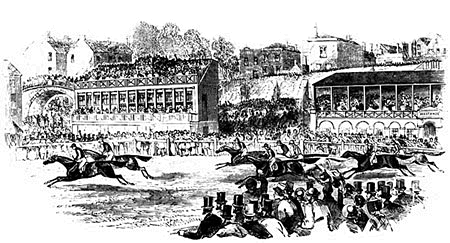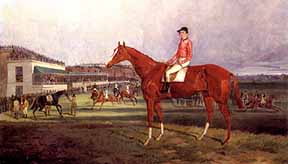 |

The home of Chester Races is the beautiful 65-acre site bearing the curious name of The Roodee- the
"Sweet rood of Chester" (Gascoigne 1575)- which derives
from the Saxon Rood- a cross and the Norse suffix Eye-
meaning an island- literally 'The Island of the Cross'. In Saxon times, the waters of the Dee covered the whole of this area with
the exception of a small island upon which stood a stone cross, the stump
of which you may still see in the middle of the racecourse today. |
|
Away!
'the
Corner'
is
deserted;
Away to Chester's ancient walls! A thousand screaming trains have started; 'Tis neck or nothing- Pleasure calls. From every ingle of our islands, From east and west, and north and south, From Walmer to Glengarry's highlands, From Galway to the Bull and Mouth, Away they come! the peer and peasant, Age and youth, the fright and beauty, Rolling toward the city pleasant, And every steed will do its duty. (Anonymous 1848) |

|
|
More
recently,
the
editor
of
the
Racing
Post,
Howard
Wright,
said
of
the
Roodee: "Chester
racecourse
is
one
of
the
most
progressive
and
best-run
courses
in
the
country
and
has
done
exceptionally
well
in
pulling
the
crowds.
The
attraction
of
the
course
is
its
smallness-
in
Chester's
case,
small
is
definitely
beautiful
as
this
allows
it
to
become
a
theatre
where
punters
can
see
all
of
the
action." An extract from 'Chester: A Virtual Stroll Around the Walls': The Roodee |